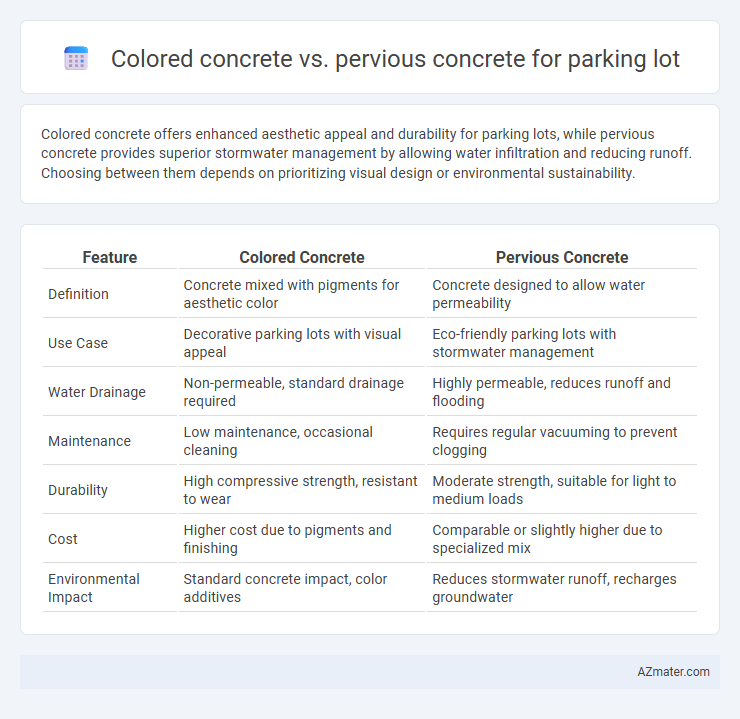Colored concrete offers enhanced aesthetic appeal and durability for parking lots, while pervious concrete provides superior stormwater management by allowing water infiltration and reducing runoff. Choosing between them depends on prioritizing visual design or environmental sustainability.
Table of Comparison
| Feature | Colored Concrete | Pervious Concrete |
|---|---|---|
| Definition | Concrete mixed with pigments for aesthetic color | Concrete designed to allow water permeability |
| Use Case | Decorative parking lots with visual appeal | Eco-friendly parking lots with stormwater management |
| Water Drainage | Non-permeable, standard drainage required | Highly permeable, reduces runoff and flooding |
| Maintenance | Low maintenance, occasional cleaning | Requires regular vacuuming to prevent clogging |
| Durability | High compressive strength, resistant to wear | Moderate strength, suitable for light to medium loads |
| Cost | Higher cost due to pigments and finishing | Comparable or slightly higher due to specialized mix |
| Environmental Impact | Standard concrete impact, color additives | Reduces stormwater runoff, recharges groundwater |
Overview: Colored Concrete vs Pervious Concrete
Colored concrete enhances parking lot aesthetics by integrating pigmented aggregates or dyes into the mix, providing customizable design options and improved surface durability. Pervious concrete, characterized by its high porosity, facilitates stormwater drainage and reduces runoff, promoting sustainable water management in parking areas. Both materials offer distinct functional benefits: colored concrete prioritizes visual appeal and strength, while pervious concrete focuses on environmental performance and infiltration capacity.
Material Composition and Structure
Colored concrete for parking lots is composed of Portland cement, aggregates, water, and synthetic or mineral pigments, creating a dense and durable surface ideal for aesthetic appeal and long-lasting performance. Pervious concrete, made from cement, coarse aggregates, water, and little to no fine aggregates, forms a highly porous and permeable structure that facilitates stormwater infiltration and reduces runoff. The structural difference lies in colored concrete's solid matrix that supports heavy loads, whereas pervious concrete's interconnected voids prioritize water drainage, influencing material selection based on functional needs.
Aesthetic Appeal and Design Flexibility
Colored concrete offers a wide range of hues and patterns that enhance the aesthetic appeal of parking lots, allowing for creative designs, branding, and integration with surrounding landscapes. Pervious concrete provides a more natural, muted finish that prioritizes functionality and stormwater management but limits color options and decorative effects. Design flexibility is higher with colored concrete, enabling customized visual elements, while pervious concrete focuses on environmental benefits with less emphasis on varied aesthetics.
Permeability and Drainage Performance
Pervious concrete offers superior permeability compared to colored concrete, allowing water to pass through its porous structure and significantly enhancing drainage performance in parking lots. This permeability reduces surface runoff, decreases the risk of flooding, and promotes groundwater recharge. In contrast, colored concrete, while aesthetically versatile, typically has a denser composition that limits water infiltration and requires additional drainage solutions to manage stormwater effectively.
Environmental Impact and Sustainability
Colored concrete reduces urban heat island effects by reflecting more sunlight and offers long-lasting aesthetic appeal, minimizing the need for frequent repairs or replacements. Pervious concrete enhances stormwater management by allowing water infiltration, reducing runoff, and recharging groundwater, thereby supporting sustainable urban water cycles. Both materials contribute to environmentally responsible parking lot design but serve distinct sustainability roles in heat mitigation and water conservation.
Installation Process and Construction Time
Colored concrete installation for parking lots involves standard mixing and pouring techniques with the addition of integral pigments or surface stains, which does not significantly extend construction time beyond typical curing periods of 7 to 28 days. Pervious concrete requires careful placement and compaction to maintain its porous structure, often necessitating skilled labor and specialized equipment, which can slightly increase installation complexity and reduce initial work speed. Construction time for pervious concrete may vary due to meticulous water management and curing processes essential for optimal permeability and structural integrity.
Durability and Longevity in Parking Lots
Colored concrete offers enhanced durability with its UV-resistant pigments and dense surface, making it resistant to fading and surface wear in parking lots. Pervious concrete provides excellent water drainage, reducing freeze-thaw cycling damage and extending pavement life, but it typically has lower compressive strength compared to colored concrete. For long-term performance, colored concrete withstands heavy traffic and aggressive chemical exposure better, while pervious concrete prioritizes environmental benefits with moderate durability.
Maintenance Requirements and Costs
Colored concrete requires regular sealing to maintain its vibrant appearance and prevent fading, with maintenance costs typically ranging from $0.50 to $1.50 per square foot annually. Pervious concrete demands frequent cleaning, such as vacuum sweeping or pressure washing, to prevent clogging and maintain permeability, with maintenance expenses around $0.10 to $0.30 per square foot per year. Initial installation costs for colored concrete often range from $8 to $12 per square foot, while pervious concrete installation costs vary between $6 and $10 per square foot, influencing long-term maintenance budgeting.
Climate Suitability and Regional Considerations
Colored concrete offers excellent UV resistance and durability, making it suitable for hot, sunny climates where heat absorption can be a concern for parking lots. Pervious concrete enhances runoff management by allowing water infiltration, ideal for regions with high rainfall or stringent stormwater regulations, reducing flooding and improving groundwater recharge. Regional considerations must include local climate patterns and environmental regulations to select the concrete type that balances aesthetic appeal and sustainable drainage performance.
Cost Analysis and Budget Planning
Colored concrete for parking lots generally incurs higher initial costs due to pigment additives and specialized mixing, ranging from $7 to $12 per square foot, while pervious concrete costs approximately $8 to $15 per square foot influenced by installation complexity and drainage requirements. Budget planning must account for long-term maintenance expenses, with colored concrete requiring periodic sealing to preserve aesthetics, whereas pervious concrete offers potential savings by reducing stormwater management infrastructure. Cost efficiency depends on project scope, with colored concrete favored for visual impact and pervious concrete optimized for sustainable water management and regulatory compliance.

Infographic: Colored concrete vs Pervious concrete for Parking Lot
 azmater.com
azmater.com